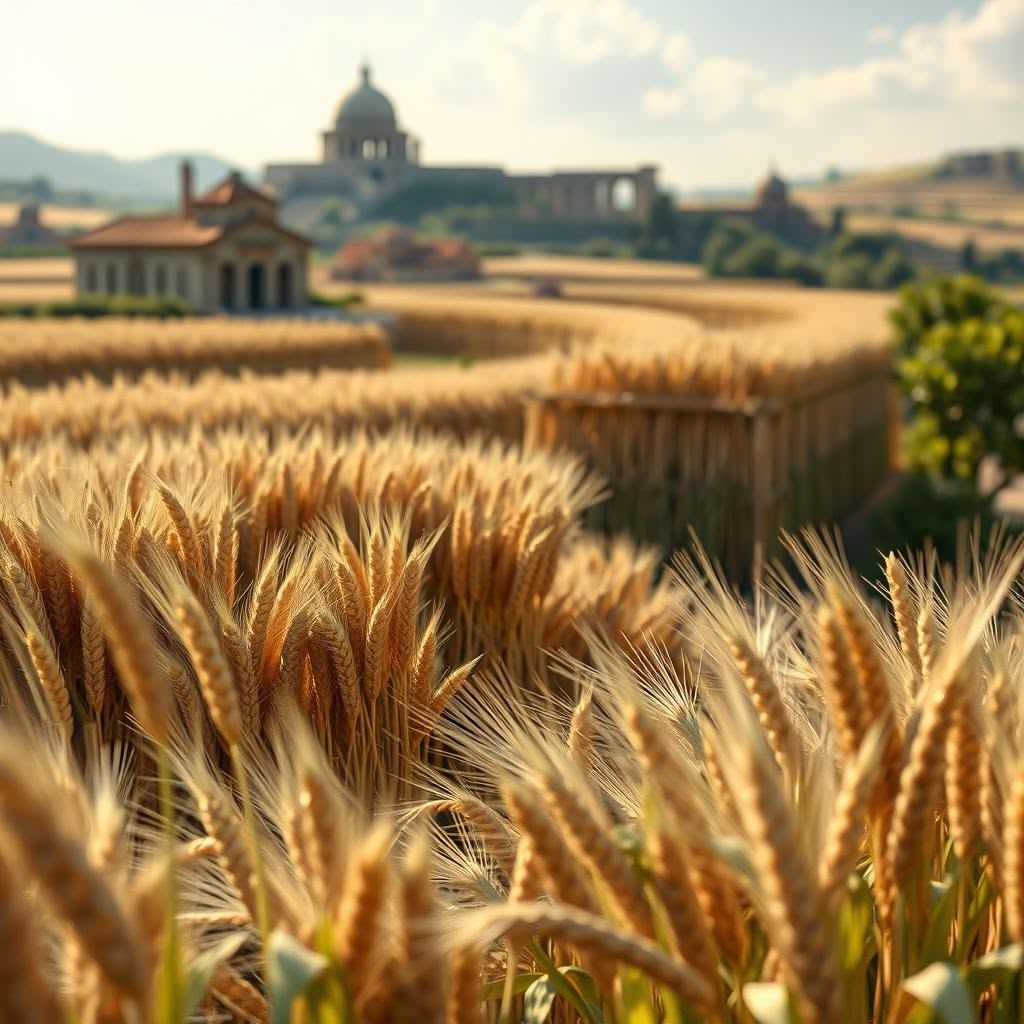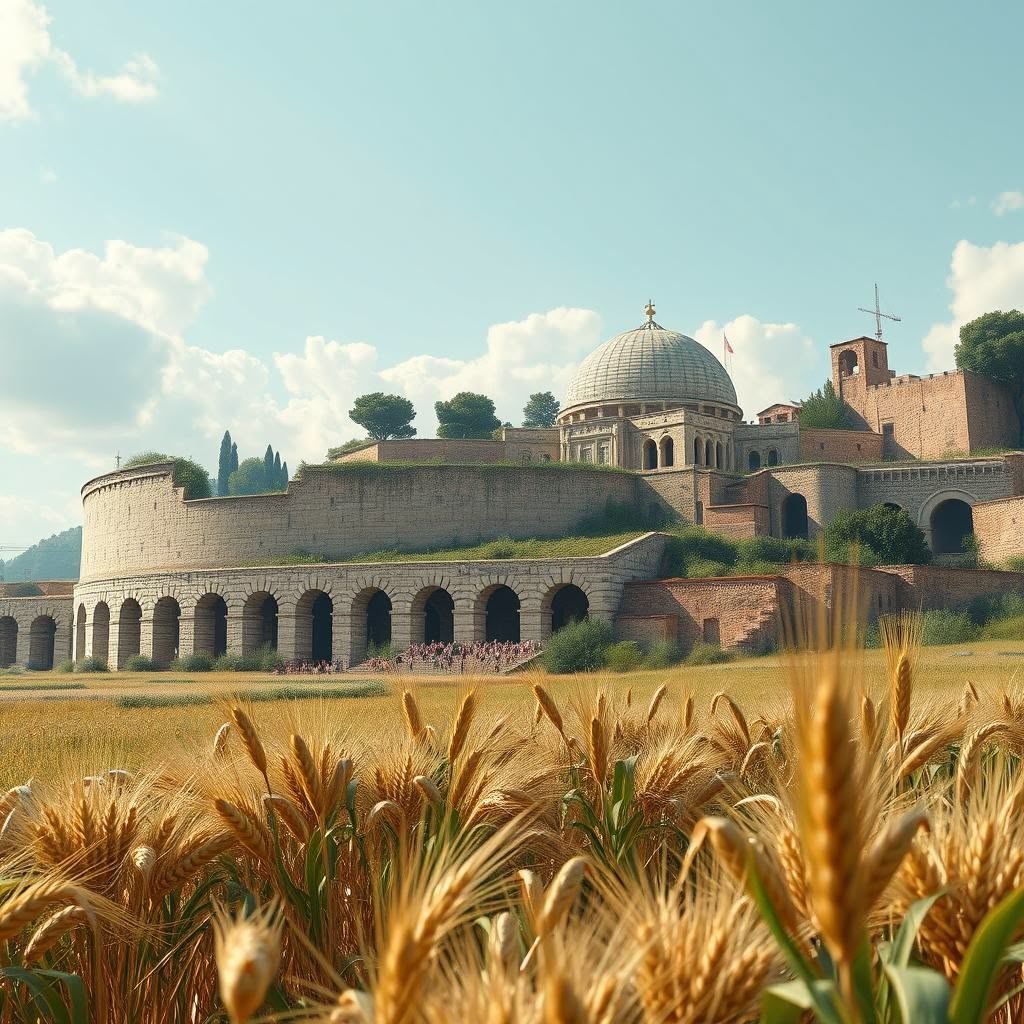The Cura Annonae system was vital for sustaining the urban population of Imperial Rome, which swelled to approximately one million people by the 2nd century AD. This intricate logistics network was responsible for procuring and distributing grain across the city, ensuring food security for its inhabitants.
Key aspects of the Cura Annonae include:
- Grain Sources: Primarily sourced from provinces such as Egypt, North Africa, and Sicily.
- Transportation Methods: Involved a combination of maritime and overland transport facilitated by private merchants and ships.
- Effective Governance: The Roman state regulated grain distribution to maintain social stability and prevent unrest among citizens. This aspect of governance is part of a larger structure that marked a significant transition in governance from monarchy to a complex political structure during the Roman Republic, which laid the foundation for modern democracies.
The success of the Cura Annonae depended on this complex interplay of grain sources, transportation methods—which included some incredible Roman engineering feats that ensured effective governance and cultural exchange—and efficient governance, highlighting its significance in the fabric of Roman society.

The Emergence of the Cura Annonae
The establishment of the Cura Annonae was a crucial response to the food supply challenges faced by ancient Rome. As the urban population grew, reaching around one million by the 2nd century AD, traditional farming methods struggled to keep up with the rising demand for grain. Key historical factors include:
- Frequent food shortages caused by poor harvests, political instability, and military conflicts.
- A growing reliance on imported grain from provinces like Egypt and North Africa, which required a dependable distribution system.
In this situation, the Cura Annonae came into being as a state-controlled logistics system aimed at efficiently managing grain distribution. Several reasons motivated its creation:
- To ensure a consistent supply of food to city dwellers and avert famine.
- To maintain social stability by offering subsidized or free bread through the grain dole initiated by Augustus.
The Cura Annonae not only tackled immediate food security issues but also played a vital role in governance. By overseeing grain distribution, Roman leaders could quell potential unrest among citizens, ensuring loyalty and compliance in an expanding city. This complex interplay between logistics and social order laid the groundwork for Rome’s lasting impact on urban governance.
However, food supply was not the only concern for the rulers of ancient Rome. The entertainment sector, which included gladiator games, chariot races, and theatrical performances, played a crucial role in society. These spectacles were not merely forms of entertainment; they significantly influenced social relationships and political authority.
Moreover, agriculture was not just about feeding the population; it was also a crucial driver of economic growth. The agricultural sector extended beyond mere food production, contributing significantly to Rome’s economic and social development.
The legacy of Ancient Rome remains a cornerstone of Western civilization. From its inception as a small city-state to its transformation into a vast empire, Rome’s influence is both profound and enduring. The impact of Roman culture, governance, and innovations can be seen in various aspects of modern society. For those interested in exploring more about this fascinating world of Ancient Rome, Men of Pompeii offers engaging content that brings the past to life.

Sources and Transportation of Grain Supply
The Role of Private Merchants and Ships in Roman Grain Distribution
The grain supply of Rome depended heavily on private merchants who played a crucial role in the distribution process. These individuals, often wealthy citizens, were responsible for sourcing grain from various provinces, including Egypt, North Africa, and Sicily. Their involvement transformed the grain trade into a thriving commercial enterprise that supported both local economies and the urban population of Rome.
Shipping Logistics
Private merchants managed shipping logistics, ensuring that grain was transported efficiently from farms to ports and ultimately to Rome. They coordinated with shipbuilders and crews, optimizing routes and schedules to maximize cargo capacity. This network included:
- Conductores: Contractors who organized transport logistics.
- Ship Owners: Individuals who maintained vessels used for transporting grain.
Types of Ships Used for Transporting Grain
Different types of ships were employed in the Roman grain trade, each designed to meet specific logistical needs. The most common vessels included:
- Navis oneraria: Large cargo ships capable of carrying substantial loads.
- Liburna: Originally developed as a fast warship, this vessel later adapted for commercial purposes due to its speed and maneuverability.
The design elements of these ships facilitated not only the loading and unloading processes but also ensured safe passage through various maritime conditions. Efficient vessel design contributed significantly to the timely arrival of grain necessary for sustaining the growing urban population.
Grain imports were critical in meeting Rome’s vast demand. With annual requirements reaching approximately 40 million modii, private merchants played an indispensable role in maintaining this flow. Their expertise in shipping logistics allowed for a well-organized grain supply chain that supported the Cura Annonae system, ultimately feeding an empire reliant on effective governance and social stability.
As merchant activities progressed, they laid the groundwork for complex transportation networks that would evolve over time, ensuring Rome’s urban fabric remained nourished and resilient against potential challenges ahead.
In addition to these historical insights into the grain supply chain, it’s fascinating how some aspects of this ancient world are still being explored today through immersive experiences like those offered in role-playing games such as Second Life. These platforms allow users to engage with historical contexts in unique ways.
Moreover, understanding the broader implications of such logistical operations can shed light on other facets of Roman society like the military strategies that shaped its expansion or even delve into cultural aspects such as the role of gladiators within Roman entertainment.
Transportation Networks and Processes from Farms to Ports
The grain supply chain in ancient Rome relied on an intricate network of transportation methods, facilitating the movement of grain from provinces to the bustling city. Key provinces contributing to this supply included:
- Egypt: Renowned for its fertile lands along the Nile, Egypt was a primary supplier of grain.
- North Africa: Regions like Tunisia and Libya provided substantial amounts of wheat and barley.
- Sicily: This island played a crucial role in grain production, serving as an important source for Roman imports.
To transport grain efficiently, Romans utilized various methods:
- Canals: These were vital for inland transport, allowing grain from farms to reach larger waterways.
- Roads: Well-maintained Roman roads connected rural areas to ports, enabling smooth overland movement.
Ports served as essential gateways for maritime trade. Notable ports included:
- Alexandria: A key hub for Egyptian grain exports, facilitating large shipments to Rome.
- Ostia: The primary port of Rome, where ships unloaded grain cargoes before distribution within the city.
Private merchants played a crucial role in this logistics framework, ensuring that the vast amounts of grain needed were consistently transported. Efficient shipping logistics were paramount in sustaining the urban population through the Cura Annonae system.
The daily life in ancient Rome was vastly different for various social classes, especially the patricians and plebeians. This social class divide significantly influenced their daily activities, traditions, and ways of living. Notably, figures like Scipio Africanus, known for his crucial role in the Second Punic War, played a significant part in shaping these dynamics. His victory over Hannibal established Rome’s dominance over Carthage and had far-reaching consequences for the Mediterranean region.
Moreover, understanding Roman law is essential as its principles continue to influence modern legal systems today.
Storage and Distribution Mechanisms Within Rome’s Urban Fabric
The successful operation of the Cura Annonae depended heavily on effective storage and distribution systems. Central to this was the horrea, public warehouses strategically located throughout Rome. These facilities played a critical role in managing grain imports from key provinces such as Egypt, North Africa, and Sicily.
Key features of horrea included:
- Large Capacity: Designed to accommodate vast quantities of grain, ensuring ample supply for the urban populace.
- Optimal Conditions: Constructed with ventilation and insulation to preserve grain quality and prevent spoilage.
- Accessibility: Positioned near major transportation routes, facilitating efficient distribution across the city.
The integration of horrea into Rome’s urban fabric allowed for streamlined logistics, which were essential in meeting the demands of a growing population. As grain arrived via various trade routes, including maritime pathways from crucial ports, these warehouses ensured timely access to sustenance for the citizens of Rome.
This efficient management of resources not only fed the populace but also supported the broader economic framework that allowed philosophical ideas, such as those from Stoicism, to flourish in Roman society. Stoicism, a philosophical school founded in ancient Greece, emphasized living in harmony with nature, using reason, and practicing virtue as paths to achieving human flourishing. These ideas became popular in Roman culture, influencing the thoughts and actions of important thinkers throughout the empire.

Annual Grain Requirements and Demand Dynamics in Imperial Rome
The grain demand in Imperial Rome, was immense, driven by a population that swelled to around one million by the 2nd century AD. To sustain this urban populace, the Cura Annonae established a robust framework for grain supply.
Estimating Annual Grain Needs
Annual grain requirements were estimated at approximately 40 million modii (about 272,000 tonnes). This measurement accounted for the dietary needs of residents, primarily relying on bread as a staple food.
The Role of the Grain Dole Program
The grain dole program initiated by Augustus provided subsidized or free bread to roughly 200,000 adult male citizens, linking food supply directly to social stability.
Logistics and Governance
Achieving such vast quantities necessitated extensive logistical planning and an efficient transport network. The sheer scale of grain procurement and distribution reflects the sophisticated nature of Roman governance and its commitment to maintaining order within the city.
Social Implications
This commitment was not only crucial for feeding the large population but also for ensuring the stability of different social classes in Rome.
The Plebeians
The [plebeians](https://www.menofpompeii.com/the-lives-of-plebeians-romes-common-people), who made up the majority of the population, relied heavily on these grain supplies for their sustenance. They were vital to the fabric of Roman society and significantly influenced the development of political and economic structures.
The Patricians
On the other hand, the patricians, who constituted the wealthy elite, had a different relationship with these resources. Their status as rich landowners often placed them in a position of power and luxury, distinct from the working-class plebeians.

Challenges Faced by the Cura Annonae System Over Time
The Cura Annonae system, while essential for feeding Imperial Rome, faced significant challenges in maintaining its effectiveness. Key issues included:
1. Harvest Reliability
The system was heavily reliant on good harvests from various provinces such as Egypt and North Africa. A poor harvest could lead to severe shortages, directly impacting the grain supply. The unpredictability of agricultural yields created a precarious situation for the city’s population.
2. External Conflicts
Wars and political instability often disrupted supply lines. For instance, military campaigns could divert resources and attention away from grain transportation, leading to delays or halts in shipments. Furthermore, blockades or piracy in the Mediterranean posed additional risks to merchant vessels.
These challenges necessitated a robust governance structure within the Cura Annonae. Authorities had to continuously monitor agricultural conditions across regions to anticipate potential shortages and implement contingency plans. Ensuring a steady grain supply required not only effective logistics but also an understanding of the broader socio-political landscape that could influence transportation and distribution channels. The interplay between agricultural reliability and external conflicts highlighted the vulnerabilities within this critical supply system.
The complexities of managing such a vital system were further compounded by the overarching rise and fall of the Roman Empire, which was not merely a political entity but a tapestry woven from diverse cultures, languages, and traditions. This vast empire was marked by remarkable architectural masterpieces that served as a testament to their power and cultural identity.
Additionally, the influence of Roman mythology on modern culture reflects the deep-rooted societal norms and political aspirations that shaped their governance. Understanding these aspects is crucial to grasping the complexities of Roman governance, including its transition from monarchy to a republican system during the birth of the Roman Republic.
Moreover, the rich art and culture in ancient Rome, characterized by remarkable artistic expressions influenced by earlier Greek and Etruscan traditions, adds another layer of complexity to our understanding of this period.

Legacy and Lessons from the Roman Grain Supply System for Modern Logistics Practices
The historical evolution of the Cura Annonae offers valuable insights for contemporary supply chain management. Key takeaways include:
- Complex Networks: The integration of various stakeholders, including private merchants and government oversight, mirrors today’s logistics strategies involving multiple partners.
- Adaptability: Rome’s grain system adapted to challenges such as harvest variability and external conflicts, emphasizing the importance of flexibility in modern operations.
- Efficient Storage: The use of horrea highlights the necessity of effective storage solutions to maintain product integrity.
These lessons underscore how ancient practices can inform current approaches to managing complex supply chains. Additionally, the Twelve Tables, which were a significant milestone in the development of Roman law, provide further context on how legal frameworks can shape economic systems.
It’s also important to note that the religious practices of ancient Rome intertwined with every aspect of their lives, including their economic activities. Understanding these cultural dimensions can enrich our comprehension of historical logistics practices.
Furthermore, exploring the legal status of Roman women reveals how gender dynamics were influenced by legal frameworks during that era. This aspect can shed light on the socio-economic factors at play in ancient supply chain systems.
Finally, the enduring influence of the Corpus Juris Civilis on modern law illustrates how ancient legal principles continue to shape contemporary legal systems, including those governing supply chain management.

FAQs (Frequently Asked Questions)
What was the Cura Annonae system in ancient Rome?
The Cura Annonae was a state-controlled grain distribution system established to manage the supply of grain to the urban population of Imperial Rome. It played a crucial role in sustaining the city’s food supply and maintaining social stability.
How did the Cura Annonae contribute to social stability in Rome?
The Cura Annonae helped prevent unrest among the urban masses by ensuring a consistent grain supply, which was essential for feeding the large population of Rome. Its effective governance and management of resources were key to maintaining order.
What were the primary sources of grain for Rome under the Cura Annonae?
Rome’s grain supply primarily came from provinces such as Egypt, North Africa, and Sicily. These regions were vital for meeting the city’s high demand for grain, which was facilitated through an extensive network of trade routes.
What role did private merchants play in the Roman grain distribution process?
Private merchants were integral to the grain distribution process, handling shipping logistics and transporting grain from various provinces to Rome. Their involvement ensured efficiency and flexibility in meeting the city’s demands.
What transportation methods were used to bring grain to Rome?
Grain was transported to Rome using a combination of canals for inland transport, roads for overland movement, and maritime routes through ports. Notable ports played a critical role in facilitating this maritime trade.
What challenges did the Cura Annonae system face over time?
The Cura Annonae faced challenges such as reliance on good harvests from diverse regions, which could be affected by climate conditions or conflicts. Political instability also posed risks to its smooth operation and ability to meet the growing demand for grain.

